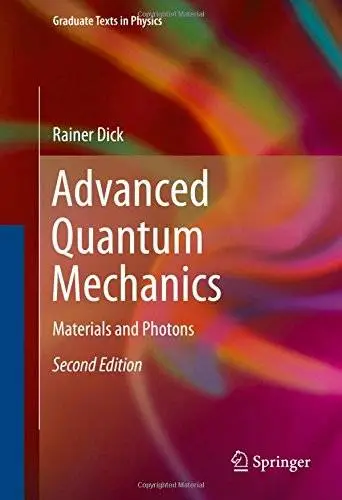Advanced Quantum Mechanics: Materials and Photons, Second Edition
Springer | Graduate Texts in Physics | August 2, 2016 | ISBN-10: 3319256742 | 630 pages | pdf | 6.9 mb
Springer | Graduate Texts in Physics | August 2, 2016 | ISBN-10: 3319256742 | 630 pages | pdf | 6.9 mb
Authors: Dick, Rainer
Introduces quantum mechanics with a unique focus on examples and applications in materials science and photon-matter interactions
Presents advanced quantum mechanics clearly enough to make it accessible to graduate students in physics, chemistry and engineering
Includes over 150 problems to aid in student's comprehension
In this updated and expanded second edition of a well-received and invaluable textbook, Prof. Dick emphasizes the importance of advanced quantum mechanics for materials science and all experimental techniques which employ photon absorption, emission, or scattering. Important aspects of introductory quantum mechanics are covered in the first seven chapters to make the subject self-contained and accessible for a wide audience. Advanced Quantum Mechanics, Materials and Photons can therefore be used for advanced undergraduate courses and introductory graduate courses which are targeted towards students with diverse academic backgrounds from the Natural Sciences or Engineering. To enhance this inclusive aspect of making the subject as accessible as possible Appendices A and B also provide introductions to Lagrangian mechanics and the covariant formulation of electrodynamics.
This second edition includes an additional 62 new problems as well as expanded sections on relativistic quantum fields and applications of quantum electrodynamics. Other special features include an introduction to Lagrangian field theory and an integrated discussion of transition amplitudes with discrete or continuous initial or final states. Once students have acquired an understanding of basic quantum mechanics and classical field theory, canonical field quantization is easy. Furthermore, the integrated discussion of transition a
mplitudes naturally leads to the notions of transition probabilities, decay rates, absorption cross sections and scattering cross sections, which are important for all experimental techniques that use photon probes.
Quantization is first discussed for the Schrödinger field before the relativistic Maxwell, Klein-Gordon and Dirac fields are quantized. Quantized Schrödinger field theory is not only important for condensed matter physics and materials science, but also provides the easiest avenue to general field quantization and is therefore also useful for students with an interest in nuclear and particle physics. The quantization of the Maxwell field is performed in Coulomb gauge. This is the appropriate and practically most useful quantization procedure in condensed matter physics, chemistry, and materials science because it naturally separates the effects of Coulomb interactions, exchange interactions, and photon scattering. The appendices contain additional material that is usually not found in standard quantum mechanics textbooks, including a completeness proof for eigenfunctions of one-dimensional Sturm-Liouville problems, logarithms of matrices, and Green’s functions in different dimensions.
Number of Illustrations and Tables
27 b/w illustrations, 36 illustrations in colour
Topics
Quantum Physics
Quantum Optics, Quantum Electronics, Nonlinear Optics
Optical and Electronic Materials
Nanoscale Science and Technology
Nanotechnology
Click Here to Buy the Hardcover from Springer
Click Here for More books



